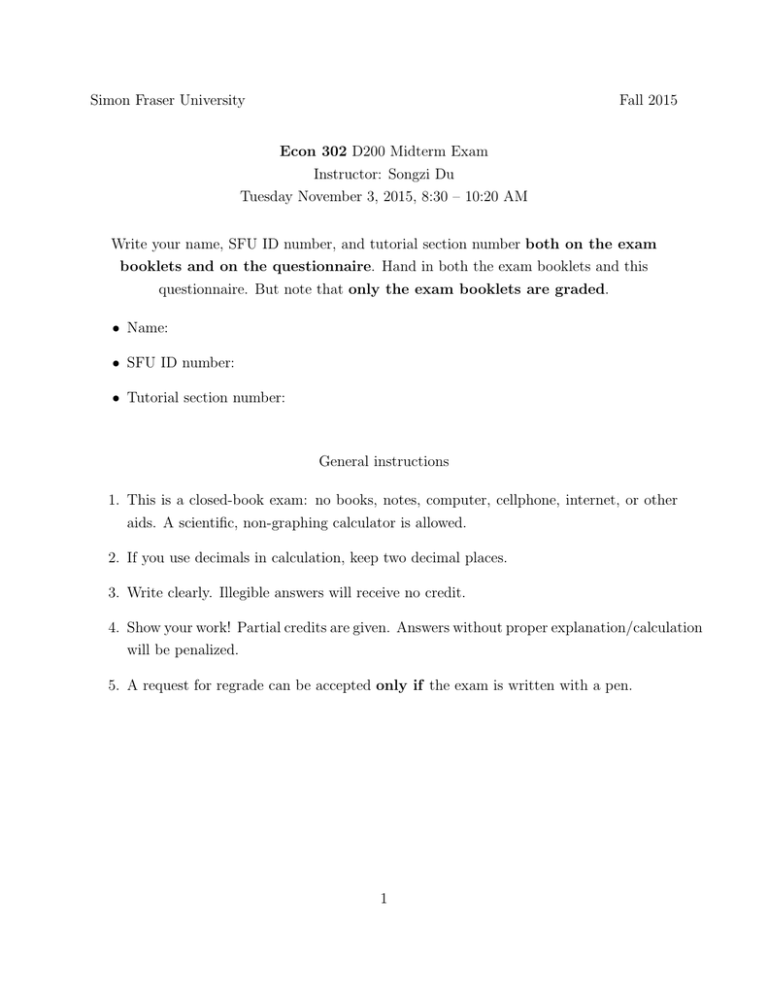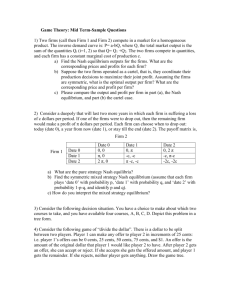Simon Fraser University Fall 2015 Econ 302 D200 Midterm Exam Instructor: Songzi Du
advertisement

Simon Fraser University
Fall 2015
Econ 302 D200 Midterm Exam
Instructor: Songzi Du
Tuesday November 3, 2015, 8:30 – 10:20 AM
Write your name, SFU ID number, and tutorial section number both on the exam
booklets and on the questionnaire. Hand in both the exam booklets and this
questionnaire. But note that only the exam booklets are graded.
• Name:
• SFU ID number:
• Tutorial section number:
General instructions
1. This is a closed-book exam: no books, notes, computer, cellphone, internet, or other
aids. A scientific, non-graphing calculator is allowed.
2. If you use decimals in calculation, keep two decimal places.
3. Write clearly. Illegible answers will receive no credit.
4. Show your work! Partial credits are given. Answers without proper explanation/calculation
will be penalized.
5. A request for regrade can be accepted only if the exam is written with a pen.
1
1. (10 points) You and your n − 1 roommates each have five hours of free time you
could spend cleaning your apartment. You all dislike cleaning, but you all like having a
clean apartment: each person’s payoff is the total hours spent (by everyone) cleaning, minus
a number c times the hours spent (individually) cleaning. That is, each roommate i gets:
ui (s1 , s2 , . . . , sn ) = −csi +
n
X
sj ,
j=1
where 0 ≤ sj ≤ 5 is the hours spent by roommate j cleaning. Assume everyone chooses
simultaneously how much time to spend cleaning.
(a) Find the Nash equilibrium if c < 1.
(b) Find the Nash equilibrium if c > 1.
(c) Set n = 5 and c = 2. Is the Nash equilibrium outcome Pareto efficient? If not, can you
find an outcome in which everyone is better off than in the Nash equilibrium outcome?
2. (10 points) Player 1 is a police officer who must decide whether to patrol the streets
or to hang out at the coffee shop. His payoff from hanging out at the coffee shop is 10, while
his payoff from patrolling the streets depends on whether he catches a robber, who is player
2. If the robber prowls the streets then the police officer will catch him and obtain a payoff
of 20. If the robber stays in his hideaway then the officer’s payoff is 0. The robber must
choose between staying hidden or prowling the streets. If he stays hidden then his payoff
is 0, while if he prowls the streets his payoff is −10 if the officer is patrolling the streets
and 10 if the officer is at the coffee shop. Suppose the officer and the robber make decision
simultaneously.
(a) Write the payoff matrix for this game.
(b) Find the Nash equilibrium (pure and mixed) of this game. What are the players’ expected
payoffs in the Nash equilibria?
3. (15 points) Two staff managers in a student dormitory, the house manager (player
1) and kitchen manager (player 2), must select a resident assistant from a pool of three
candidates: {a, b, c}. Player 1 prefers a to b, and b to c. Player 2 prefers b to a, and a
2
to c. The process that is imposed on them is as follows: First, the house manager vetoes
one of the candidates and announces the veto to the central office for staff selection and to
the kitchen manager. Next the kitchen manager vetoes one of the remaining two candidates
and announces it to the central office. Finally the director of the central office assigns the
remaining candidate to be the resident assistant.
(Veto means to reject.)
(a) Model this as an extensive-form game (using a game tree) in which a player’s mostpreferred candidate gives a payoff of 2, the second most-preferred candidate gives a
payoff of 1, and the last candidate gives 0. Draw the game tree.
(b) Find and describe the subgame-perfect equilibrium for this game.
(c) Now assume that before the two players play the game, player 2 can send an alienating
e-mail to one of the candidates, which would result in that candidate withdrawing her
application. Would player 2 choose to do this, and if so, with which candidate? Explain
by considering the subgame perfect equilibrium outcome following the withdraw of each
candidate.
4. (10 points) Suppose that there are 200 symmetric firms each with a constant marginal
cost of 2 and a fixed cost of 5. They first decide (simultaneously) whether to enter or not
enter a market. A firm that does not enter gets payoff 0. A firm i that enters the market
sees the other firms that have entered, plays a Cournot (quantity competition) game with
the others given a demand Q = 60 − P , and earns a payoff of P · qi − 2qi − 5. Find the
subgame perfect equilibria in pure strategy. What are the firms’ profits in these equilibria?
5. (10 points) Consider the following dynamic game: Player 1 can choose to play it safe
(denote this choice by S), in which case both he and player 2 get a payoff of 3 each, or he
can risk playing a game with player 2 (denote this choice by R). If he chooses R then they
play the following simultaneous-move game:
A
B
C
8, 0
0, 2
D
6, 6
2, 2
3
(a) Draw a game tree that represents this game.
(b) Find and describe all subgame perfect equilibria (pure and mixed) of this game.
6. (10 points) Find and describe all pure-strategy subgame perfect equilibria (if any)
in the following games. You can restrict attention to equilibrium in which player 2 chooses
B-No. Show the steps that you use to find the SPE.
In this game player 1 is either a good type or a bad type, each is realized with probability
1/2.
4








